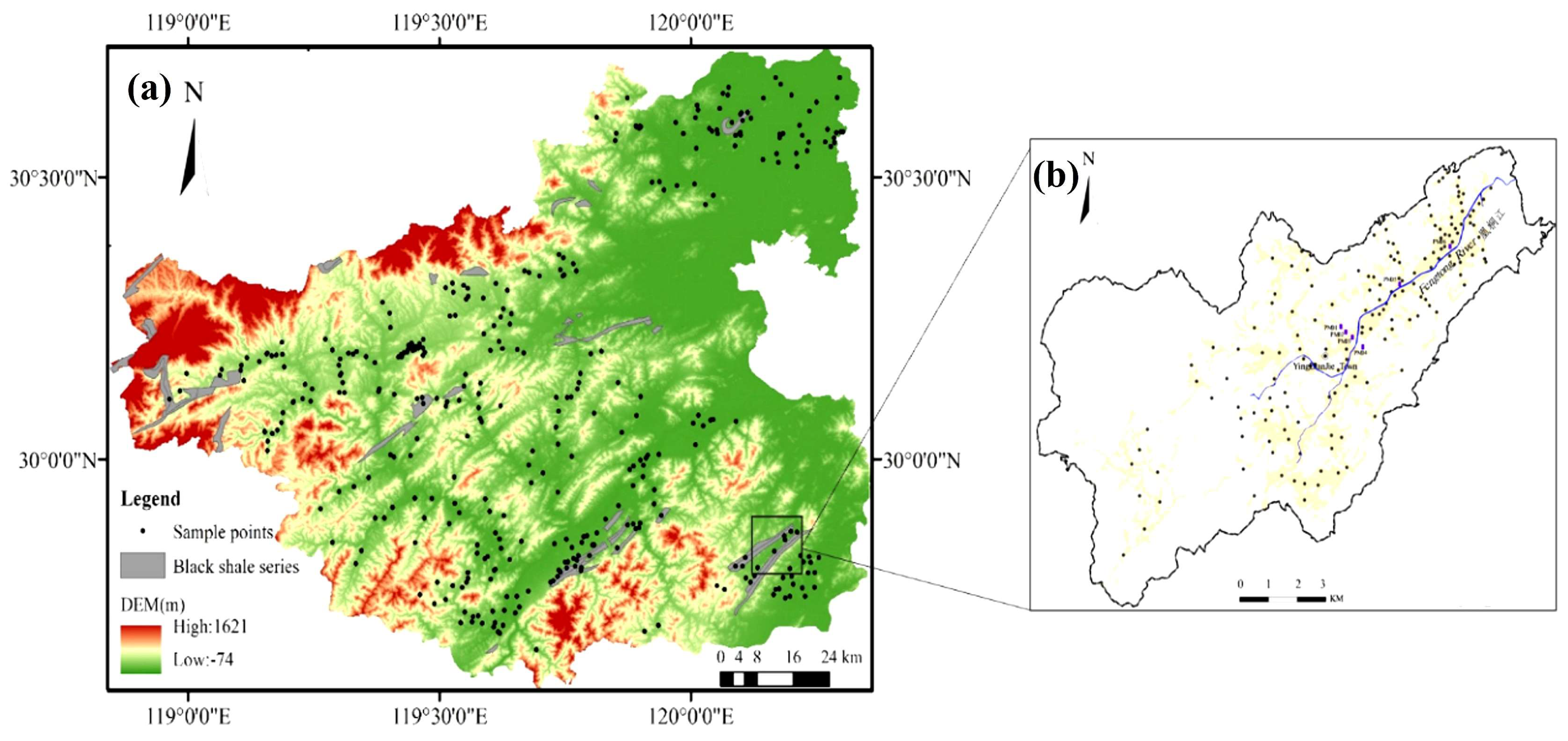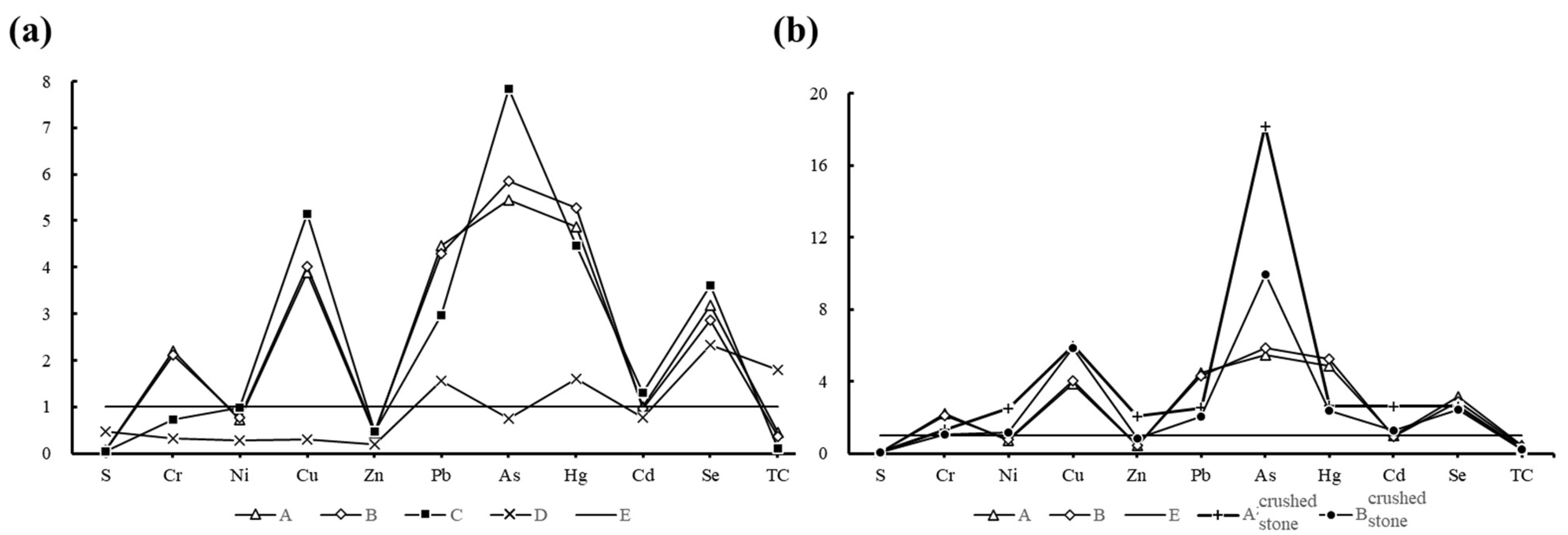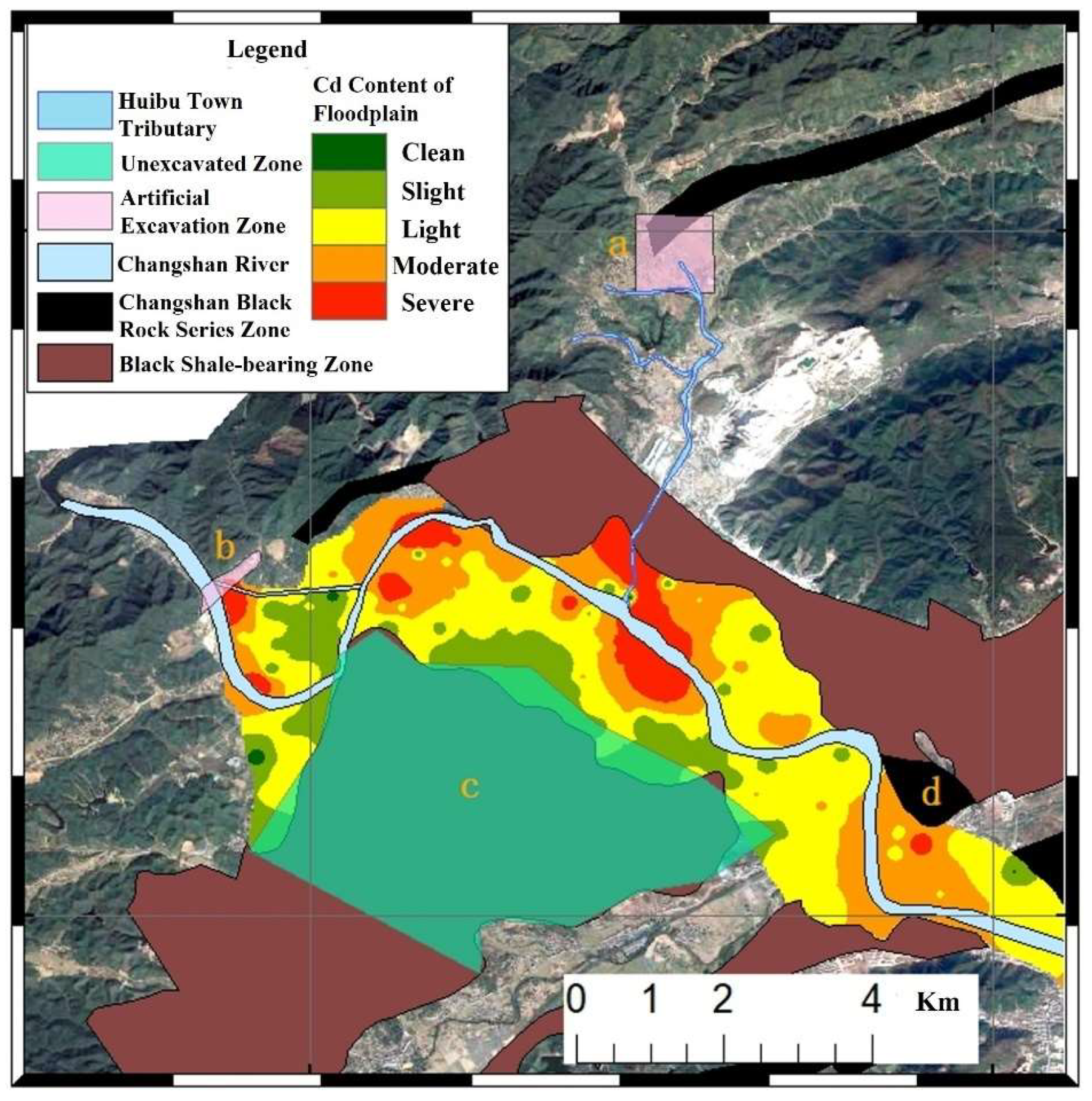Potentially Toxic Element Migration Characteristics and Bioavailability in Soils of the Black Shale Region, Western Zhejiang Province, China
Abstract
1. Introduction
2. Materials and Methods
2.1. Study Area Overview
2.2. Field Investigation and Sampling
2.2.1. Geochemical Survey and Soil Sampling
2.2.2. Typical Soil Profile Sampling
2.2.3. Water Sample Collection
2.2.4. Rice Sample Collection
2.3. Sample Analysis
2.3.1. Total Element and Physicochemical Analysis of Soils and Crops
- (1)
- Cd, Cu, Ni (Nickel), and Se: Inductively coupled plasma mass spectrometry (ICP-MS);
- (2)
- Pb, Zn: X-ray fluorescence spectrometry (XRF);
- (3)
- As: Hydride generation atomic fluorescence spectrometry (HG-AFS);
- (4)
- Hg: Cold vapor atomic fluorescence spectrometry (CV-AFS);
- (5)
- pH: Glass electrode method;
- (6)
- Organic matter: High-frequency heating infrared absorption method.
2.3.2. Water Sample Analysis
2.3.3. Extraction Methods of Soil and Crop Components
- 1.
- Water-soluble form
- 2.
- Exchangeable form
- 3.
- Carbonate-bound form
- 4.
- Weakly crystalline Fe-Mn oxide-bound form
- 5.
- Crystalline Fe-oxide form
- 6.
- Organic-bound form
- 7.
- Residual form
- 8.
- Experimental Operation
2.4. Analytical Quality Control
2.4.1. Soil Sample Quality Control
2.4.2. Crop Sample Quality Control
2.5. Data Processing Methods
2.6. Technical Standards and Regulations
3. Results and Discussion
3.1. Distribution and Accumulation Characteristics of PTEs in Typical Black Shale Soils
3.2. Mineral Composition and PTE Migration/Accumulation Characteristics in Typical Black Shale Weathering Profiles
3.3. Migration Characteristics of PTEs in Surface Runoff and Irrigation Water
3.3.1. Elemental Characteristics of Surface Water
3.3.2. PTE Characteristics in Agricultural Soils of Typical Black Shale Watersheds
- (1)
- The Changshan River water is weakly alkaline (pH 7.6–7.9) and is characterized by high levels of Na+, Ca2+, K+, Cl−, F−, and SO42−. The mountain streams have high levels of HCO3−, Fe, and Mg; the mine wastewater in the exposed black rock series area, with its strong acidity, high PTE (Cd, As) content, and high SO42− levels, directly leads to a decrease in the pH of the surrounding soils, an increase in the total amount of Cd/As, and an increase in the proportion of exchangeable Cd. The mountain streams in non-exposed areas have a clean water quality, corresponding to low PTE content and stable speciation in the soil.
- (2)
- The outcrop location of the black rock series controls the PTE pollution source. Surface runoff serves as the migration carrier, and its flow velocity and discharge determine the migration distance of PTEs in water and the scope of soil pollution. The speciation of PTEs in the solution (such as ionic state, particle-bound state) affects their occurrence forms in the soil (exchangeable state, residual state, etc.) [29].
- (3)
- The river sedimentation process causes PTEs (such as Cd, Pb) carried by suspended particles in water to accumulate in the soil, resulting in a significantly higher total amount of PTEs in the soil of the deposition area than in the non-deposition area, forming an enrichment zone [2].
3.4. Speciation Characteristics of PTEs in Farmland Soils of Exposed Black Shale Areas
4. Conclusions
Supplementary Materials
Author Contributions
Funding
Institutional Review Board Statement
Informed Consent Statement
Data Availability Statement
Conflicts of Interest
References
- Wei, Y.; Zhao, Z.; He, J.; Nie, Y.; Xu, L.; Xu, A.; Wu, L. Connection between health risk and heavy metals in agricultural soils of China: A study based on current field investigations. Environ. Geochem. Health 2023, 45, 7775–7789. [Google Scholar] [CrossRef]
- Chen, L.; Ren, B.; Deng, X.; Yin, W.; Cai, Z. Black shale high geological background potential toxic elements(PTEs) in middle reaches of the Yangtze River tributary basin water environment, China: Distribution, pollution sources, and risk assessment. J. Hazard. Mater. 2024, 480, 136132. [Google Scholar] [CrossRef]
- Xia, X.; Yang, Z.; Yu, T.; Zhang, C.; Hou, Q. Predicting spatial and temporal variation of Cd concentration in rice grains in the Lower Changjiang Plain during 2004–2014 based on soil geochemical survey data with GIS. J. Geochem. Explor. 2019, 200, 276–283. [Google Scholar] [CrossRef]
- Kerr, A.C. Oceanic plateau formation: A cause of mass extinction and black shale deposition around the Cenomanian–Turonian boundary? J. Geol. Soc. 1998, 155, 619–626. [Google Scholar] [CrossRef]
- Lu, X. Effects of Urbanization Andindustrial and Mining Developmenton the Accumulation of Pollutants Inthe Agricultural Soils and Theireco-Environmental Risk Assessmentsin Zhejiang Province, Southeast China. Ph.D. Thesis, Shanghai University, Shanghai, China, 2020. [Google Scholar]
- Qu, S.; Wu, W.; Nel, W.; Ji, J. The behavior of metals/metalloids during natural weathering: A systematic study of the mono-lithological watersheds in the upper Pearl River Basin, China. Sci. Total Environ. 2020, 708, 134572. [Google Scholar] [CrossRef] [PubMed]
- Hu, X.; Liu, X.; Zhang, S.; Yu, C. Nitrogen-cycling processes under long-term compound heavy metal(loids) pressure around a gold mine: Stimulation of nitrite reduction. J. Environ. Sci. 2025, 147, 571–581. [Google Scholar] [CrossRef]
- Ikoyi, I.O.; Heuvelink, G.B.M.; De Goede, R.G.M. Geostatistical modelling and mapping of nematode-based soil ecological quality indices in a polluted nature reserve. Pedosphere 2021, 31, 670–682. [Google Scholar] [CrossRef]
- Zhu, Y.; Chen, B.; Lin, A. Heavy metal contamination in Pearl River Delta-Status and research priorities. Acta Sci. 2005, 25, 1575–1579. [Google Scholar]
- Lee, J.S.; Chon, H.T.; Kim, J.S.; Kim, K.W.; Moon, H.S. Enrichment of potentially toxic elements in areas underlain by black shales and slates in Korea. Environ. Geochem. Health 1998, 20, 135–147. [Google Scholar] [CrossRef]
- Mao, J.; Li, X.; Li, H.; Qu, X.; Zhang, C.; Xue, C.; Wang, Z.; Yu, J.; Zhang, Z.; Feng, C. Types and Characteristics of Endogenetic Metallic Deposits in Orogenic Belts in China and Their Metallogenic Processes. Acta Geol. Sin. 2005, 79, 342–372. [Google Scholar]
- Mao, J.; Xie, G.; Li, X.; Zhang, C.; Wang, Y. Mesozoic Large Scale Mineralization and Multiple Lithospheric Extension in South China. Earth Sci. Front. 2004, 11, 45–55. [Google Scholar]
- Wang, M. Geochemical Characteristics and Influencing Factors of Selenium-enriched Soilsin Cultivated Land Around Typical Stone Coal Mines in Western Zhejiang. Geoscience 2022, 36, 941. [Google Scholar] [CrossRef]
- Förstner, U.; Wittmann, G.T.W. Metal Pollution in the Aquatic Environment; Springer: Berlin/Heidelberg, Germany, 1983. [Google Scholar]
- Tessier, A.P.; Campbell, P.G.C.; Bisson, M. Sequential extraction procedure for the speciation of particulate trace metals. Anal. Chem. 1979, 51, 844–851. [Google Scholar] [CrossRef]
- Wang, Q.; Dong, Y.; Zheng, W.; Zhou, G. Soll geochemical baseline values and environmental background values in Zhejiang, China. Geol. Bull. China 2007, 26, 590–597. [Google Scholar]
- Xiao, H.; Tian, X.; Yuan, Y.; Liu, D.; Zhong, M.; Deng, X.; Liu, Y. Ecological risk of Cd and Cr in the black rock series should be noticed: Based on the study of enrichment mechanism, occurrence form in the Lower Cambrian Lujiaping formation. J. Hazard. Mater. 2024, 480, 136019. [Google Scholar] [CrossRef]
- Wei, W.; Ling, S.; Li, X.; Wu, X. Enrichment characteristic and health risk assessment of heavy metals in soils derived from black shale in Chengkou area, Chongqing. Environ. Chem. 2024, 43, 1601. [Google Scholar]
- Liu, Y.; Xiao, T.; Zhu, Z.; Ma, L.; Li, H.; Ning, Z. Geogenic pollution, fractionation and potential risks of Cd and Zn in soils from a mountainous region underlain by black shale. Sci. Total Environ. 2021, 760, 143426. [Google Scholar] [CrossRef]
- Gräfe, M.; Nachtegaal, M.; Sparks, D.L. Formation of Metal−Arsenate Precipitates at the Goethite−Water Interface. Environ. Sci. Technol. 2004, 38, 6561–6570. [Google Scholar] [CrossRef]
- Wei, Y.; He, J.; Xue, Y.; Nie, Y.; Liu, X.; Wu, L. Spatial distribution of multi-elements in moss revealing heavy metal precipitation in London Island, Svalbard, Arctic. Environ. Pollut. 2022, 315, 120398. [Google Scholar] [CrossRef] [PubMed]
- Liu, Y.; Xiao, T.; Perkins, R.B.; Zhu, J.; Zhu, Z.; Xiong, Y.; Ning, Z. Geogenic cadmium pollution and potential health risks, with emphasis on black shale. J. Geochem. Explor. 2017, 176, 42–49. [Google Scholar] [CrossRef]
- Pan, H.; Li, F.; Ye, W.; Wang, J. The impacts of dismantling electronic wastes on surround ing soil environment -Take Xiaguao of Lugiao Taizhou as an example. J. Zhejiang Norm. Univ. 2007, 30, 6. [Google Scholar]
- Nesbitt, H.W.; Young, G.M. Prediction of some weathering trends of plutonic and volcanic rocks based on thermodynamic and kinetic considerations. Geochim. Et Cosmochim. Acta 1984, 48, 1523–1534. [Google Scholar] [CrossRef]
- Bufe, A.; Hovius, N.; Emberson, R.; Rugenstein, J.K.C.; Galy, A.; Hassenruck-Gudipati, H.J.; Chang, J.-M. Co-variation of silicate, carbonate and sulfide weathering drives CO2 release with erosion. Nat. Geosci. 2021, 14, 211–216. [Google Scholar] [CrossRef]
- Bruemmer, G.W.; Gerth, J.; Tiller, K.G. Reaction kinetics of the adsorption and desorption of nickel, zinc and cadmium by goethite. I. Adsorption and diffusion of metals. Eur. J. Soil Sci. 1988, 39, 37–52. [Google Scholar] [CrossRef]
- Wei, W.; Ling, S.; Li, X.; Sun, C.; Feng, J.; Luo, J.; Wu, X.; He, C. Mineral-dependent release, migration and enrichment of toxic elements during black shale weathering: An integrated study from profile scale to mineral scale. J. Hazard. Mater. 2025, 487, 137119. [Google Scholar] [CrossRef] [PubMed]
- Blowes, D.W.; Ptacek, C.J.; Jambor, J.L.; Weisener, C.G. The Geochemistry of Acid Mine Drainage. Treatise Geochem. 2003, 9, 149–204. [Google Scholar]
- Tuttle, M.L.W.; Breit, G.N.; Goldhaber, M. Geochemical data from New Albany Shale, Kentucky: A study of metal mobility during weathering of black shales. In US Geological Survey Open-File Report 03-207; Scholar’s Choice: London, ON, Canada, 2003. [Google Scholar]
- Liu, Y.; Zhang; He, H. Speciation and ecological assessment of heayy metals in surface sediments of theYellow Sea and Fast China Sea. Period. Ocean. Univ. China 2018, 48, 8. [Google Scholar]
- Li, F.; Yu, T.; Huang, Z.; Jiang, T.; Wang, L.; Hou, Q.; Tang, Q.; Liu, J.; Yang, Z. Leaching experiments and risk assessment to explore the migration and risk of potentially toxic elements in soil from black shale. Sci. Total Environ. 2022, 844, 156922. [Google Scholar] [CrossRef]
- Wu, C.; Sun, B.; Tian, M.; Cheng, X.; Liu, D.; Zhou, Y. Enrichment Characteristics and Ecological Risk Assessment of Heavy Metals in a Farmland System with High Geochemical Background in the Black Shale Region of Zhejiang, China. Minerals 2024, 14, 375. [Google Scholar] [CrossRef]
- Arthur, F.W.; Susan, L.B. Chemical Weathering Rates of Silicate Minerals; De Gruyter: Berlin, Germany, 1995. [Google Scholar]
- Brantley, S.; Lebedeva, M.I. Learning to read the chemistry of regolith to understand the critical zone. Annu. Rev. Earth Planet. Sci. 2011, 39, 387–416. [Google Scholar] [CrossRef]
- Brantley, S.L.; Goldhaber, M.B.; Ragnarsdottir, K.V. Crossing disciplines and scales to understand the critical zone. Elements 2007, 3, 307–314. [Google Scholar] [CrossRef]
- Dixon, J.L.; von Blanckenburg, F. Soils as pacemakers and limiters of global silicate weathering. Comptes Rendus Geosci. 2012, 344, 597–609. [Google Scholar] [CrossRef]
- Jobbágy, E.G.; Jackson, R.B. The uplift of soil nutrients by plants: Biogeochemical consequences across scales. Ecol. Soc. Am. 2004, 85, 2380–2389. [Google Scholar] [CrossRef]
- Kalnicky, D.J.; Singhvi, R. Field portable xrf analysis of environmental samples. J. Hazard Mater 2001, 83, 93–122. [Google Scholar] [CrossRef]
- Li, C.; Han, L.; Yang, J.; Gao, J.; Lv, B. Distribution and constraints of rare earth elements in granite weathering profile from the subtropical coastal region of southeast China. Earth Environ. 2024, 4, 487–496. [Google Scholar] [CrossRef]
- Lijun, L. Genetie Characteristies and Taxonomic Classification of Hilly Soils in the Western Zhejiang Province. Master’s Thesis, Zhejiang University, Hangzhou, China, 2012. [Google Scholar]
- Lin, S.; Wu, X.; Sun, C.; Miao, X. Research on micro-mechanism and evolution of black shale in chemical weathering process. J. Chengdu Univ. Technol. Sci. Technol. Ed. 2017, 44, 10. [Google Scholar]
- Shukui, L.; Yongmei, D. Determination of heavy metal elements in soil by icp-ms. Chin. J. Inorg. Anal. Chem. 2015, 5, 4. [Google Scholar]
- Wu, Y.; Tian, H.; Gong, D.; Li, T.; Zhou, Q. Paleo-environmental variation and its control on organic matter enrichment of black shales from shallow shelf to slope regions on the upper yangtze platform during cambrian stage 3. Palaeogeogr. Palaeoclimatol. Palaeoecol. 2020, 545, 109653. [Google Scholar] [CrossRef]






| Element | Minimum | Maximum | Mean | SD | Zhejiang Background Value |
|---|---|---|---|---|---|
| As (mg kg−1) | 1.16 | 688.00 | 24.74 | 31.28 | 6.93 |
| Cd (mg kg−1) | 0.02 | 86.90 | 0.84 | 2.30 | 0.25 |
| Cr (mg kg−1) | 1.08 | 1380.92 | 78.20 | 34.00 | 79.43 |
| Cu (mg kg−1) | 5.25 | 735.00 | 39.25 | 29.41 | 49.68 |
| Hg (mg kg−1) | 0.01 | 9.96 | 0.14 | 0.19 | 0.8 |
| Ni (mg kg−1) | 1.28 | 364.00 | 37.60 | 23.23 | 31.27 |
| Pb (mg kg−1) | 11.25 | 10,273 | 45.77 | 170.96 | 58.06 |
| Zn (mg kg−1) | 27.70 | 8089.00 | 129.01 | 192.42 | 124.86 |
Disclaimer/Publisher’s Note: The statements, opinions and data contained in all publications are solely those of the individual author(s) and contributor(s) and not of MDPI and/or the editor(s). MDPI and/or the editor(s) disclaim responsibility for any injury to people or property resulting from any ideas, methods, instructions or products referred to in the content. |
© 2025 by the authors. Licensee MDPI, Basel, Switzerland. This article is an open access article distributed under the terms and conditions of the Creative Commons Attribution (CC BY) license (https://creativecommons.org/licenses/by/4.0/).
Share and Cite
Chen, H.; Chen, B.; Huang, C.; Lu, X.; Zou, R.; Wei, Y. Potentially Toxic Element Migration Characteristics and Bioavailability in Soils of the Black Shale Region, Western Zhejiang Province, China. Toxics 2025, 13, 679. https://doi.org/10.3390/toxics13080679
Chen H, Chen B, Huang C, Lu X, Zou R, Wei Y. Potentially Toxic Element Migration Characteristics and Bioavailability in Soils of the Black Shale Region, Western Zhejiang Province, China. Toxics. 2025; 13(8):679. https://doi.org/10.3390/toxics13080679
Chicago/Turabian StyleChen, Huanyuan, Baoliang Chen, Chunlei Huang, Xinzhe Lu, Ruosong Zou, and Yutong Wei. 2025. "Potentially Toxic Element Migration Characteristics and Bioavailability in Soils of the Black Shale Region, Western Zhejiang Province, China" Toxics 13, no. 8: 679. https://doi.org/10.3390/toxics13080679
APA StyleChen, H., Chen, B., Huang, C., Lu, X., Zou, R., & Wei, Y. (2025). Potentially Toxic Element Migration Characteristics and Bioavailability in Soils of the Black Shale Region, Western Zhejiang Province, China. Toxics, 13(8), 679. https://doi.org/10.3390/toxics13080679






